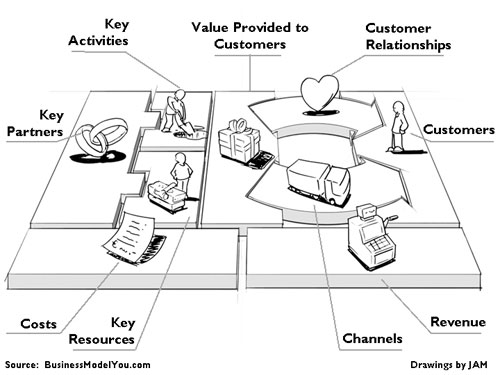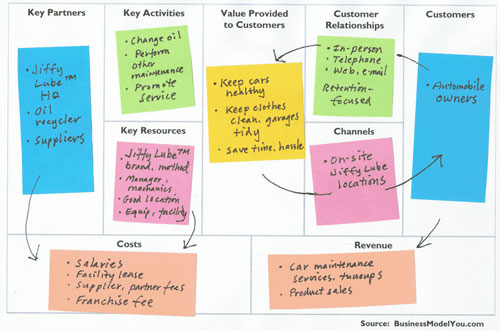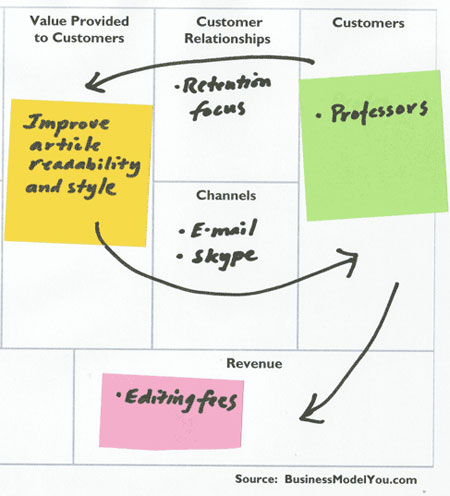Jump-start your career with a personal business model
In columns past, Get Rich Slowly has showed you how to improve your financial situation by thinking of yourself as a business. In short, the lessons of business often apply to personal life. I recently discovered this while editing a book about business models that turned into an international bestseller. (Who knew business models could be so popular?) The lesson I learned — that business model thinking can apply to individuals as well as to organizations — could help you jump-start your career.
The term “business model” may seem like jargon used by high-priced consultants and business-school professors. That’s too bad, because understanding and analyzing business models remains a rare and valuable skill — yet one anybody can learn.
What does “business model” mean, anyhow? There’s little agreement on a precise definition, but two common explanations are “a blueprint for a business” and “how a firm makes money.” These definitions are general and don’t mean exactly the same thing. Still, both suggest that business models play a key role in business success.
Why is this important?
Because most of us care greatly about our employers’ survival. And if that’s the case, then it follows that we should be keen to understand how business models apply to and help sustain the organizations we work for — as well as why new models have wreaked havoc in the telecommunications, publishing, music, and advertising industries, among others.
Among its many exciting features — such as its title — the book I edited, Business Model Generation, details a more complete definition of “business model”:
A business model describes the rationale of how an organization creates, delivers, and captures value.
In other words, a business model explains how an enterprise provides value to customers — and gets paid for doing so. Specifically, “providing value” means helping customers with a job that needs doing.
The Business Model Canvas
This logic can be expressed in the Business Model Canvas, a simple diagram that shows a business model’s nine key “building blocks.” These building blocks include Customers, Value Provided to Customers, and Channels, among others:

Let’s see how the Canvas works by diagramming the business model of Jiffy Lube, a drive-in, quick oil change service company.
Jiffy Lube helps car owners accomplish a crucial but messy, hassle-laden job: maintaining their vehicles. Jiffy Lube helps customers with this job by quickly and expertly changing oil — and saving them from dirtying their clothes or having to recycle used oil. Customers, in turn, pay Jiffy Lube for the value it provides in keeping their cars running trouble-free.
Here’s a Canvas that shows Jiffy Lube’s business model. It includes Customers (car owners), Value Provided to Customers (keeping cars running trouble-free), and Channels (how value is delivered — in Jiffy Lube’s case, on-site at Jiffy Lube locations):

Seems simple enough, right?
Here’s the key point: Though it embodies crucial organizational logic, a business model is also invisible — an undefined, intangible asset that resides…well, nowhere. Few organizations bother to formally describe their models in the form you see above. Doesn’t it seem odd that something so important so often remains invisible?
That’s the beauty and value of the Business Model Canvas. Drawing the model on paper makes typically unspoken assumptions explicit. And clarifying those assumptions makes them available for others to understand, challenge — and build upon.
Business Models Go Personal
Now, here’s some good news for us as individuals: By getting a better understanding of how our organizations work, business model thinking helps us perform more effectively at our own jobs. But more than that, once we become familiar with the Business Model Canvas, we can apply the same ideas to our own careers.
How?
Simply by thinking of ourselves as single-person enterprises with “personal business models.”
For example, we all work for others (Customers), helping them complete the jobs they need to have done (Provide Value) — and we do so through various mediums (Channels). Of course, we don’t usually use business terms to discuss our work. (Not if we want anyone to listen to us, anyhow!) But that’s where the Canvas proves useful. When we use its structure and language to help us describe what we do, we open the door to personal and professional innovation.
Last year, for instance, my friend Chris developed a side business copy-editing scholarly papers for university professors. After listening to me prattle on about business models, she decided to analyze her new job by drawing a Business Model Canvas. In the “Value Provided to Customers” building block, she wrote, “improve article readability and style.”

But after pondering Value Provided, Chris realized the job she was doing was something far more valuable: helping professors get articles published in leading scholarly journals. For university professors living in a “publish or perish” world, this was a mission-critical job indeed. Chris raised her rates significantly — and attracted more, not fewer, customers.
Clarifying your personal business model can be an eye-opening experience — or even the first step toward reinventing your career.
Interested in using these ideas to improve your own life? Here are three simple takeaways:
- Learn to use the Business Model Canvas — it’s a simple but powerful tool for both organizations and individuals.
- Like Chris, put your personal business model down on paper to clarify the value you provide to customers.
- Use sticky notes to change the content of different building blocks and imagine new ways to add customers, serve them through different channels, or boost your “value provided.”
Be Part of a Bestseller Business Model
Chris’s story isn’t unique. Anyone can profit from defining a personal business model. With this in mind, I’m now working with the authors of Business Model Generation to create a new book about applying business model ideas to personal career development.
The work is tentatively titled Business Model You. We figured a book about business models should itself adopt a non-traditional model, so that’s what we’ve done. We’re inviting readers to co-create the book by critiquing draft chapters, voting on design elements, or simply supporting the effort through online forum membership. In exchange for pre-purchasing one copy, each member will be credited within the final work as a contributing co-author. (This is a traditional paper book, not an e-book.)
Nearly 500 contributing co-authors from 45 countries joined us in the production of Business Model Generation. Now we’d like to invite GRS readers with strong interests in career development and/or writing to join us at Business Model You! While we can’t guarantee that the new book will also become a bestseller, if you join us, the odds are in our favor — and yours.
Become A Money Boss And Join 15,000 Others
Subscribe to the GRS Insider (FREE) and we’ll give you a copy of the Money Boss Manifesto (also FREE)

